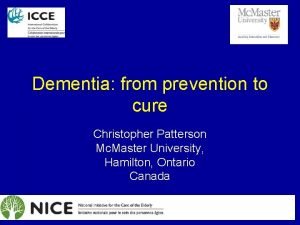Treatments and Therapy SOCIAL FAMILY THERAPY This is










- Slides: 10

Treatments and Therapy

SOCIAL – FAMILY THERAPY This is a branch of psychotherapy that works with families to nurture change and development. It tends to view change in terms of the interaction between family members and emphasizes family relationships as an important factor in psychological health. There is ongoing research into family therapy. In the case of eating disorders a study was done where 43 families were enrolled in the Maudsley Treatment programme (family therapy for patients with anorexia). After 6 months, 89% of patients no longer met the BMI criteria for an anorexic patient.

COGNITIVE - CBT Cognitive behavioural therapy is based on the idea that we learn unwanted thinking patterns over a period of time and our emotional and behavioural reactions are a result of this. CBT was used in the treatment of schizophrenia in the Sensky et al. (2000) study which showed a significant reduction of positive and negative symptoms using this treatment.

STRENGTHS: • No side effects – more ethical than other treatments. • Can be used along side otherapies. • Improves symptoms, recovery and relapse rates. WEAKNESSES: • It does not work for everybody – not generalisable • It is expensive and time consuming

LEARNING – TOKEN ECONOMY Token economy is a system that’s used to alter behaviour through positive reinforcement. Each time the individual displays a desired behaviour, they are given a token which can be exchanged for a reward. Allyon and Azrin (1968) used token economy in a psychiatric ward to treat 45 female schizophrenic patients. The results of the study showed a huge improvement in the behaviour of the schizophrenics through the incentive of privileges.

STRENGTHS: • It can produce significant improvements in self care and desirable behaviours. • Allyon and Azrin (1968) patients went from performing an average of 5 chores a day to around 40 after token economy was introduced. WEAKNESSES: • Some people do not respond to this type of conditioning • It could be considered unethical to deprive the patients of basic privileges in the first place. • Lacks ecological validity as the treatment cannot be transferred into the real world.

PSYCHODYNAMIC – DREAM ANALYSIS Freud proposed that the unconscious mind expresses itself through dreams, and that the content of a person’s dreams can reveal what is in their unconscious. Dream analysis is the process of assigning meaning to dreams. ‘the royal road to a knowledge of the unconscious activities of the mind’

Solms (2000) used PET scans to highlight the regions of the brain that are active during dreaming. The results showed that the rational part of the brain is inactive during rapid eye movement (REM) sleep, whereas the forebrain centres concerned with memory and motivation are very active. This supports Freud’s idea that our memories and desires are involved with our dreams. STRENGTHS: • It aims to treat the cause of the disorder, not just the symptoms • Patients have more control over their own treatment in comparison with otherapies. WEAKNESSES: • Other forms of treatment eg CBT have been found to be more effective. • Dream analysis is made on subjective data and the unconscious mind. This makes it difficult to validate, especially when false memories can develop in patients.

BIOLOGICAL - CHEMOTHERAPY Since the 1950 s the use of drugs to treat mental disorders has become widespread. They work to either increase or decrease the levels of neurotransmitters in the brain.

STRENGTHS: • It is successful for a large number of patients so they are able to live a more normal life. • It is the most widely used form of treatment for mental illnesses, especially schizophrenia. WEAKNESSES: • Szasz (1960) argued that biological treatments do not address the underlying causes of the mental illness and uses the labels of illness to treat them – this could be seen as unethical as patients are put in a ‘chemical straightjacket’. • There are long term side effects of chemotherapy including an increased risk of diabetes.



















